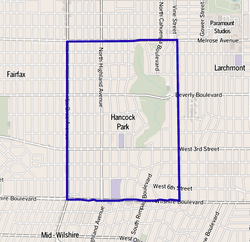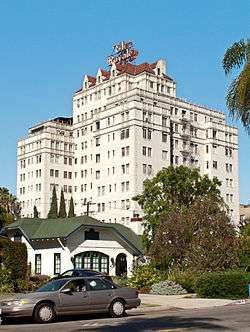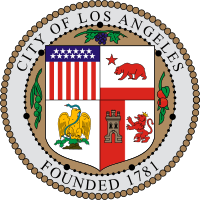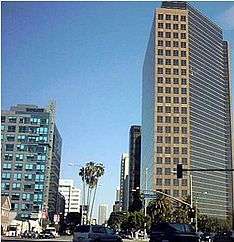Hancock Park, Los Angeles
| Hancock Park, Los Angeles | |
|---|---|
| Neighborhood of Los Angeles | |
 A street in Hancock Park, Fourth Street | |
 Map of Hancock Park, Los Angeles, as delineated by the Los Angeles Times | |
 Hancock Park, Los Angeles Location within Central Los Angeles | |
| Coordinates: 34°04′34″N 118°20′01″W / 34.07619°N 118.33348°WCoordinates: 34°04′34″N 118°20′01″W / 34.07619°N 118.33348°W | |
| Country |
|
| State |
|
| County |
|
| City |
|
Hancock Park is a historic and affluent residential neighborhood in the central region of the City of Los Angeles, California. It has many mansions from the early 20th century. Many celebrities have been known to live here. Hancock Park is built around the grounds of a private golf club. Developed in the 1920s, the neighborhood features architecturally distinctive residences.
The neighborhood is low density, with a 70.7% white, highly educated, older-aged population of 10,600+ people. Most of the residents are home owners. There are four private and two public schools in the area.
History
Hancock Park was developed in the 1920s by the Hancock family with profits earned from oil drilling in the former Rancho La Brea. The area owes its name to developer-philanthropist George Allan Hancock, who subdivided the property in the 1920s.[1][2] Hancock, born and raised in a home at what is now the La Brea tar pits, inherited 4,400 acres (18 km2), which his father, Major Henry Hancock had acquired from the Rancho La Brea property owned by the family of Jose Jorge Rocha.[3]
Hancock Park activists were also instrumental in the passage of a 1986 Congressional ban on tunneling through the neighborhood. The ban, sponsored by Congressman Henry Waxman, prevented the Red Line Subway from being routed along Wilshire Boulevard through the neighborhood.
Geography
According to the Mapping L.A. project of the Los Angeles Times, Hancock Park is flanked by Hollywood to the north, Larchmont and Windsor Square to the east, Koreatown to the southeast, Mid-Wilshire to the south and southwest and Fairfax to the west.[4] Street boundaries are Melrose Avenue on the north, Arden Boulevard on the east, Wilshire Boulevard on the south and La Brea Avenue on the west. The neighborhood surrounds the grounds of the Wilshire Country Club.[5][6] As of 2007, the Hancock Park homeowners association counted about 1,200 homes within the boundaries of Melrose Avenue, Wilshire Boulevard and both sides of Highland and Rossmore avenues.[7]
Demographics

The 2000 U.S. census counted 9,804 residents in the 1.59-square-mile neighborhood—an average of 6,459 people per square mile, including the expanse of the Wilshire Country Club. That figure gave Hancock Park one of the lowest densities in Los Angeles. In 2008, the city estimated that the population had increased to 10,671. The median age for residents was 37, considered old when compared with the city as a whole; the percentages of residents aged 35 and above were among the county's highest.[5]
Hancock Park was moderately diverse ethnically. The breakdown was whites, 70.7%; Asians, 13.1%; Latinos, 8.5%; blacks, 3.8%, and others, 3.9%. Korea and the Philippines were the most common places of birth for the 26.3% of the residents who were born abroad, a figure that was considered low compared to rest of the city.[5]
The median yearly household income in 2008 dollars was $85,277, a relatively high figure for Los Angeles, and a high percentage of households earned $125,000 or more. The average household size of 2.1 people was low for the city of Los Angeles. Renters occupied 52.7% of the housing units, and house- or apartment owners 47.3%.[5]
The percentages of never-married men and women, 41.3% and 34.4%, respectively, were among the county's highest. The 2000 census found 203 families headed by single parents, a low rate for both the city and he county. The percentage of military veterans who served during World War II or Korea was among the county's highest.[5]
Orthodox Jews
Hancock Park has a population of Orthodox Jews. According to Teresa Watanabe of the Los Angeles Times there are no clear figures but an estimate of 20% by the Jewish Journal."[7] Hancock Park is home to nearly all subsections of Orthodox Judaism; of particular note is the large population of Chasidic Jews. The Chasidic Jewish population is growing at an above-average rate due to high birth rates within the community.[8] Orthodox Jews are required to be in walking distance to their synagogues, and Hancock Park is in walking distance to the La Brea Avenue-area synagogues. Teresa Watanabe stated some Orthodox families cited the large size of houses as a reason for moving there, others cited a higher housing value compared to Beverly Hills, and other cited a proximity to the Yavneh Hebrew Academy. As of 2007 there were six Jews on the 16-member board of directors of the Hancock Park Homeowners Association.[7] As of 2007 the number of Orthodox Jews in Hancock Park is increasing. As of that year there had been disputes between Orthodox Jews and their neighbors.[9]
Education

Hancock Park residents were considered highly educated, 56.2% of those aged 25 and older having earned a four-year degree. The percentage of residents with a master's degree was high for the county.[5]
The schools operating within the Hancock Park borders are:[10]
- Yeshiva Rav Isacsohn/Torath Emeth, private elementary, 540 North La Brea Avenue
- Bnos Esther, private high school, 116 North La Brea Avenue
- Third Street Elementary School, LAUSD, 201 South June Street
- Samuel A. Fryer Yavneh Hebrew School, private elementary, 5353 West Third Street
- Marlborough School, private school for young women, 250 South Rossmore Avenue
- John Burroughs Middle School, LAUSD, 600 South McCadden Place
Residences of consuls general
Multiple residences of consuls general are within Hancock Park.[7]
Since 1957, the residence of the Los Angeles British Consuls-General has been in a home designed by the renowned architect Wallace Neff and completed in 1928. The residence is at the Hancock Park address of 450 S. June St., Los Angeles, CA 90004, and backs the Wilshire Country Club. The residence was where Prince William, Duke of Cambridge and Catherine, Duchess of Cambridge stayed in July 2011 on their first visit to the United States after their wedding.[11]
Notable people
- Antonio Banderas[7]
- Anacani, actress, singer and accomplished seamstress
- Stacey Bendet, fashion designer[12]
- Nat King Cole, singer[13] and first black resident[14]
- Natalie Cole, singer[15]
- Jan Crull, Jr. [16]
- Eric Eisner, producer[12]
- Bruce Feirstein, writer[17]
- Melanie Griffith[7]
- Patricia Heaton, actress
- Leonard Hill, television executive and real estate developer[18]
- Milla Jovovich, actress, model and musician
- Mindy Kaling, actress and writer
- Mike Murphy[19]
- Lou Rawls, singer[20]
- David Schwimmer, actor
- Tavis Smiley, talk show host[21]
- James Spader, actor
- George Takei, actor and activist
- Maxine Waters
- Mae West, actress, singer and comedian
- Lilly Singh, youtuber, comedian and actress
See also
References
- ↑ "Hancock Park". Windsor Square-Hancock Park Historical Society. Archived from the original on April 23, 2010. Retrieved June 19, 2010.
Hancock Park owes its name to developer-philanthropist G. Allan Hancock who sub-divided the property in the 1920s. Hancock, born in San Francisco, but raised in a home at the La Brea Tar Pits, inherited the 440 acres which his father, Major Henry Hancock, had acquired from the Rancho LaBrea property owned by the family of Jose Jorge Rocha. ...
- ↑ "Brief History". Hancock Park Homeowners Association. Retrieved June 19, 2010.
Hancock Park, located in the eastern portion of the original Rancho La Brea area, was purchased by Major Henry Hancock in 1863. The residential subdivision of Hancock Park was developed by Major Hancock’s son, G. Allan Hancock, in the 1920s. Outstanding architects of the era designed the palatial two-story, single family residences in various Period Revival styles (including Tudor Revival, English Revival, Spanish Colonial Revival, Mediterranean Revival, Monterey Revival, and American Colonial Revival) for influential members of Los Angeles society. The vast majority of the residences are set back 50 feet from the street, as insisted upon by G. Allan Hancock, and include side driveways generally leading though a porte cochere to a rear garage. Previous prominent Hancock Park residents have included millionaire Howard Hughes, entertainers Mae West and Nat King Cole, Broadway Department Store magnate Arthur Letts Jr., and architect William Pereira.
- ↑ "Rancho La Brea". LA Okay. Retrieved June 19, 2010.
On January 6, 1828 Rancho La Brea was granted to Antonio Jose Rocha and Nemisio Dominguez by Jose Antonio Carrillo, the Alcalde of Los Angeles. The grant included a stipulation that the tar pits within the rancho would be open and available to all the citizens of the pueblo for their use. The title was confirmed by Jose Echeandia, who was the Governor of Alta California at the time. Later in 1840, it was reconfirmed by Governor Juan B. Alvarado
- ↑ "Central L.A.", Mapping L.A., Los Angeles Times
- 1 2 3 4 5 6 "Hancock Park", Mapping L.A., Los Angeles Times
- ↑ Thomas Guide, Los Angeles County, 2004, pages 593 and 633
- 1 2 3 4 5 6 Watanabe, Teresa. "Change drives tension in staid Hancock Park." Los Angeles Times. October 1, 2007. p. 2. Retrieved on April 2, 2014.
- ↑ "Two Neighborhoods Reveal Orthodox Community's Fault Lines," Jewish Journal, July 9, 2006
- ↑ Watanabe, Teresa. "Change drives tension in staid Hancock Park." Los Angeles Times. October 1, 2007. p. 1. Retrieved on April 2, 2014.
- ↑ "Hancock Park Schools", Mapping L.A., Los Angeles Times
- ↑ "The residence".
- 1 2 PropertyShark.com
- ↑ Levinson, Peter J. (January 1, 2005). September in the Rain: The Life of Nelson Riddle. Taylor Trade Publications. p. 89. ISBN 978-1-58979-163-3.
- ↑ Davis, Mike (September 17, 2006). City of Quartz: Excavating the Future in Los Angeles (New Edition). Verso Books. p. 214n23. ISBN 978-1-84467-568-5.
Nat King Cole was the pioneer Black homeowner in the exclusive Hancock Park section of the old Westside in the early 1950s. His wealthy white neighbors burnt crosses on his lawn and generally refused to speak to him for more than a decade.
- ↑ "Singer Natalie Cole Dies at 65". Variety. Retrieved January 9, 2016.
- ↑ owned/lived on the 600 block of North Highland Avenue back in 1971-72 while at Paramount Pictures as a reader/independent assistant producer and also teaching during the same time in a Chicago ghetto school
- ↑ Feirstein, Bruce (December 22, 2012). "Where Every Street Is Sunset Boulevard". The Wall Street Journal. p. A15. Retrieved December 30, 2012.
- ↑ Leovy, Jill (June 9, 2016). "Leonard Hill dies at 68; developer converted old downtown L.A. buildings into lofts". Los Angeles Times. Retrieved July 2, 2016.
- ↑ Mehta, Seema (March 8, 2016). "Super PAC consultant who spent $100 million on Jeb Bush is unapologetic". The Los Angeles Times. California. Retrieved February 12, 2018.
- ↑ "Gainesville Sun - Google News Archive Search". news.google.com. Retrieved January 9, 2016.
- ↑ Sanneh, Kelefa (August 4, 2008). "What He Knows For Sure". The New Yorker. Retrieved November 4, 2011.
External links
| Wikimedia Commons has media related to Hancock Park. |

